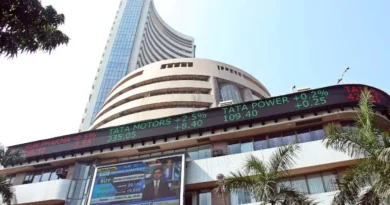Stock Market Today: Top 10 things to know before the market opens on 14th september
The benchmark Sensex and Nifty indices are likely to open marginally higher on September 14 as trends in the GIFT Nifty indicate a positive start for the broader index with a gain of 33 points.
The BSE Sensex rose 246 points to 67,467, while the Nifty50 climbed 77 points to end at a new closing high of 20,070 in the previous close and formed a bullish candlestick pattern on the daily charts, though stayed within the previous day’s trading range throughout the session.
“Notably, it closed above this threshold, marking a historic closing high for the Nifty.
The prevailing sentiment remains optimistic, contingent on Put writers safeguarding the 19,900 levels.
A drop below 19,900 could unsettle put writers, potentially triggering market corrections,” Rupak De, senior technical analyst at LKP Securities said.
On the upside, he feels the 20,100-20,150 range is poised to act as resistance.
A clear breakthrough above 20,150 might propel the Nifty into a sustained upward trend, he said.
The pivot point calculator indicates that the Nifty may be taking support at 19,979, followed by 19,943 and 19,884.
On the higher side, 20,095 can act as the key resistance followed by 20,131 and 20,190.
Stay tuned to Moneycontrol to find out what happens in the currency and equity markets today.
We have collated a list of important headlines across news platforms, which could impact Indian as well as international markets.
GIFT Nifty
The GIFT Nifty indicates a marginally positive start for the broader index with a gain of 33 points. GIFT Nifty futures stood at 20,167 points after making a high of 20,174 points.
US Markets
Stock futures oscillated near the flat line Wednesday as traders prepared for the August producer price index, a measure of wholesale inflation.
Futures tied to the Dow Jones Industrial Average added 11 points or 0.03%. S&P 500 futures ticked up 0.09%, while Nasdaq 100 futures inched 0.1% higher.
During Wednesday’s regular trading, the 30-stock Dow stumbled for a second consecutive day, dropping 0.2%, dragged down by 3M. The Nasdaq Composite closed higher by nearly 0.3%, while the S&P 500 added 0.1%.
The August reading of the consumer price index was a key event for traders.
The core CPI, which excludes food and energy, gained 0.3% from the prior month and 4.3% from 12 months earlier.
That compares against estimates of 0.2% and 4.3%, respectively, according to economists polled by Dow Jones.
Headline inflation, meanwhile, increased 0.6% on a monthly basis and 3.7% from the prior year, while economists had called for 0.6% and 3.6%.
The August CPI reading isn’t expected to change the Federal Reserve’s course at its policy meeting beginning Sept. 19.
Fed funds futures pricing data from Wednesday shows a 97% likelihood of rates remaining unchanged next week, according to the CME FedWatch Tool.
Even if the central bank holds steady on rates this time, markets will likely continue to be volatile in the coming months.
Indeed, fed funds futures pricing data shows a roughly 48% probability that rates will rise at the November meeting.
European Markets
European stock markets closed slightly lower Wednesday as investors reacted to stronger than expected U.S. inflation data.
The Stoxx 600 index ended down by 0.3%, with sectors and major bourses in negative territory. Retail stocks dropped 0.9% to lead losses.
It comes shortly after U.S. inflation data for August exceeded expectations.
The consumer price index, which measures costs across a broad variety of goods and services, rose 3.7% from a year ago, the U.S. Department of Labor reported Wednesday.
Economists surveyed by Dow Jones had forecast an increase of 3.6%. On a monthly basis, prices increased 0.6%, in line with expectations.
Core CPI, which strips out food and energy and is closely monitored by the Federal Reserve, rose by 0.3% on the month and 4.3% on the year. Economists polled by Dow Jones signaled rises of 0.2% and 4.3%, respectively.
Asian Markets
Asia-Pacific markets rose across the board even as inflation in the U.S. inflation rate in August came in hotter than expected, at 3.7% compared to economists’ expectations of 3.6% in a Dow Jones survey.
Month-on-month, the consumer price index rose 0.6% in August, in line with expectations.
In July, the CPI rose 3.2% year-on-year and 0.2% month-on-month. However, excluding volatile food and energy costs, the core CPI rose 4.3%, in line with estimates and down from 4.7% in July.
Federal Reserve officials focus more on core as it provides a better indication of where inflation is heading over the long term.
In Australia, the S&P/ASX 200 climbed marginally, ahead of August unemployment figures. Japan’s Nikkei 225 rose 0.5%, while the Topix saw a smaller gain of 0.4%. South Korea’s Kospi inched up 0.43%, and the Kosdaq was 0.84% higher
Futures for Hong Kong’s Hang Seng index stood at 18,042, also pointing to a stronger open compared to the HSI’s close of 18,009.22.
The madcap run that has triggered the mid-cap fall in five charts
The sudden and steep cut in mid-cap stocks has caused panic among investors.
While market participants say that valuations overall are not exuberant, some segments of the market have run up far ahead of what their fundamentals would justify.
This is in part triggered by investors trying to chase the performance of mid-caps and small-caps which has resulted in an avalanche of fund flows into mid- and small-cap categories of equity funds.
With too much money chasing too few stocks, stock valuations have zoomed in certain pockets that promise high growth.
The following charts, sourced from the Kotak Institutional Equities report, tell the stock of the great madcap run.
Over the last four months, mid-cap and small-cap funds of domestic equity mutual funds have seen inflows of Rs 215 billion while large-cap and flexi-cap funds have seen outflows of Rs 60 billion for the same period.
This is despite the fact that market fundamentals have not changed much. This is exuberance, according to Kotak analysts.
Next 2-3 years will see ‘very high’ FII inflows: Abakkus’ Sunil Singhania
Long term investors in India don’t have anything to worry about, and those who remain invested for a long time will see good returns, according to renowned investment manager Sunil Singhania.
The equities markets may soon find new targets to achieve after the Nifty 50 recently topped the 20,000-mark, Singhania said in an interview with CNBC Aawaaz.
India is entering a very good growth phase, and the equity markets will ride along, he added.
Every 2- 4 years, the market hits different targets. That is expected. As the economy continues to grow, the market will also grow,” Singhania said.
Earlier on September 11, the NSE Nifty 50 hit 20,000 points for the first time ever.
The benchmark has rapidly risen around 13% from 17,624 points in the last 6 months, led by both domestic and foreign investors, and shrugging off global concerns.
The Indian economy’s potential can be seen through a renewed focus on growth, through initiatives and announcements made at the recently-concluded G20 summit in New Delhi, Singhania said.
Adani in talks for $3.5 billion, one of top Asia loans this year
Adani Group is in talks with banks to refinance debt taken on to fund its purchase of Ambuja Cements Ltd, with lenders divided into three categories in what could be one of Asia’s largest syndicated loan deals of the year.
Banks are likely to refinance a total of $3.5 billion, according to people familiar with the matter, who asked not to be named because the matter is private. Adani would repay at least $300 million on the original Ambuja facility, they said.
The Indian conglomerate backed by billionaire Gautam Adani has been in talks with lenders for several months as it seeks to refinance as much as $3.8 billion worth of debt taken for its Ambuja acquisition. DBS Group Holdings Ltd., First Abu Dhabi Bank PJSC, Mizuho Financial Group Inc, Mitsubishi UFJ Financial Group, Inc. and Sumitomo Mitsui Banking Corp. would each lend about $400 million, said the people. Other banks would lend smaller amounts.
Reliance Retail in talks with Gulf, Singapore funds on $1.5 billion injection
India’s Reliance Retail is in talks with existing investors including the sovereign wealth funds of Singapore, Abu Dhabi and Saudi Arabia for combined new investments of around $1.5 billion, three sources with direct knowledge of the plan said. Reliance Retail is India’s largest retailer and is led by Asia’s richest person Mukesh Ambani.
The talks with investors are part of an internal target to raise $3.5 billion which the company wants to close by the end September, Reuters has reported. Of that, QIA last month announced a $1 billion investment and KKR & Co this week $250 million.
Singapore’s GIC, the Abu Dhabi Investment Authority (ADIA) and Saudi Arabia’s Public Investment Fund (PIF) are looking to invest at least $500 million each in Reliance Retail at a valuation of $100 billion, one of the sources told Reuters.
GIC, ADIA declined to comment, while PIF did not respond to Reuters requests for comment. Reliance said: “we do not comment on media speculation and rumours”.
Oil Prices
Oil prices traded higher on Wednesday as expected tight crude supply for the rest of the year offset inflation concerns.
Saudi Arabia and Russia’s extension of 1.3 million barrels per day (bpd) of crude oil production cuts to the end of this year will lock in a substantial market deficit through the fourth quarter, the International Energy Agency (IEA) said on Wednesday.
The continuing supply cuts could lift Brent futures above the $100 a barrel threshold before the end of the year, Bank of America analysts said on Wednesday. U.S. consumer prices rose in August by their most in more than a year, the Bureau of Labor Statistics said on Wednesday, driven by a 10.6% increase in retail gasoline prices.
Excluding volatile food and energy components, the consumer price index rose by 0.3%.
Benchmark Brent futures rose 40 cents, or 0.43%, to $92.46 a barrel by 1252 GMT while U.S. West Texas Intermediate (WTI) crude gained 41 cents, or 0.46%, to $89.25.
Front-month Brent futures contracts traded as high as $4.68 a barrel above those for delivery six months further out on Tuesday, a width of spread not breached since last November, indicating tighter market supply.
Meanwhile, forecasters expect the European Central Bank to raise interest rates at its meeting on Thursday.
Dollar Index
The Dollar index traded 0.06 percent lower in futures at 104.65, whereas the value of one dollar hovered near Rs 83.09.
Gold Prices
Gold steadied on Wednesday after retreating immediately following data showing an acceleration in U.S. consumer prices, on expectations that the inflation readings may not prompt a big change in the Federal Reserve’s interest rate strategy. Spot gold was steady at $1,912.86 per ounce. U.S. gold futures were also steady at $1,935.40 per ounce.
The Labor Department data showed headline and core CPI in August rose 0.6% and 0.3%, respectively, month-on-month. Economists were expecting increases of 0.6% and 0.2%, respectively.
However, traders’ expectations for the Fed leaving interest rates unchanged at its Sept. 19-20 policy meeting only got stronger after the data, while pricing around a 44% chance of another hike before 2024, according to the CME FedWatch tool.
Precious metal investors are less worried about higher inflation and more focused on the opportunity costs associated with holding a non-interest bearing asset in a rising rate environment,” said Chris Gaffney, president at EverBank World Markets.
But “focus now shifts to the retail sales numbers which some investors feel is an even more important indicator than the CPI info we got today.”
FIIs and DIIs
Foreign institutional investors (FII) sold shares worth Rs 1,631.63 crore, while domestic institutional investors (DII) bought Rs 849.86 crore worth of stocks on September 13, provisional data from the National Stock Exchange (NSE) showed.
ByMoneycontrol




